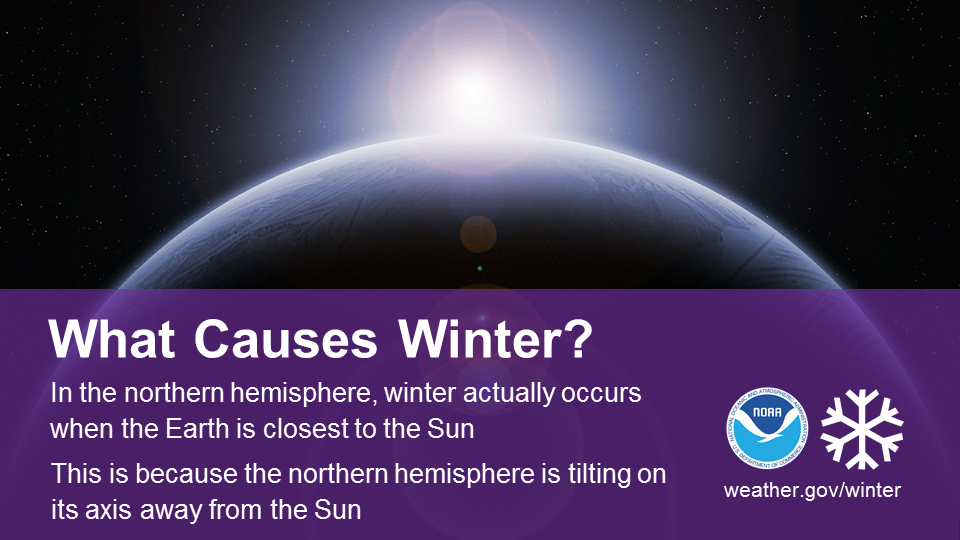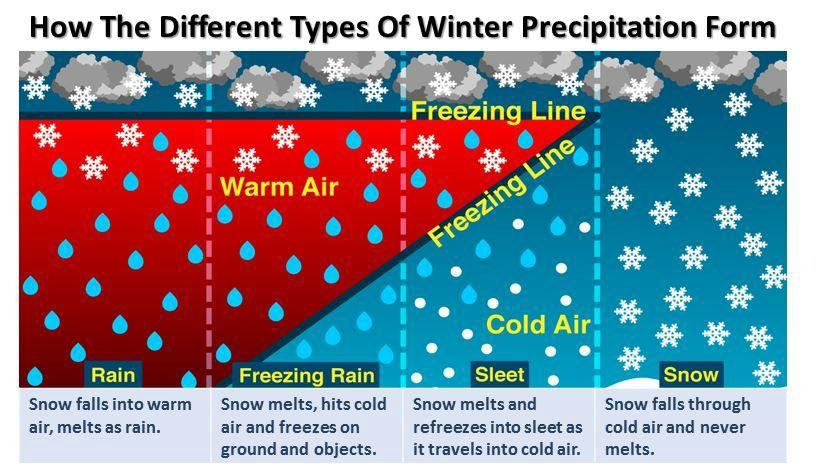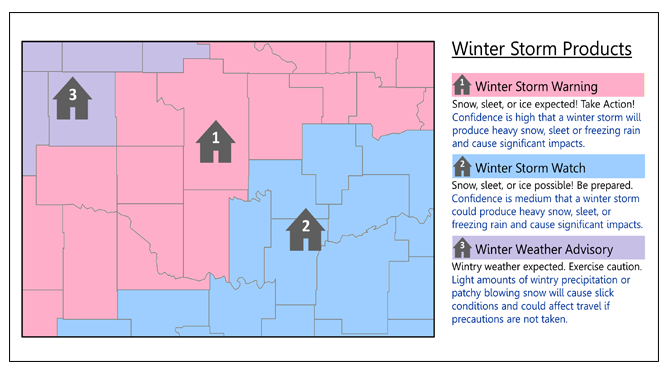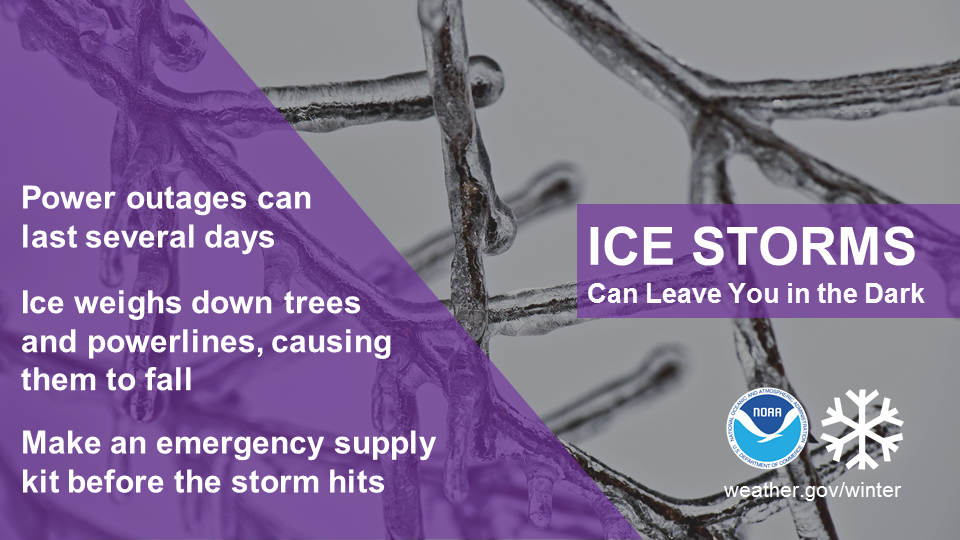Please help the National Weather Service spread these important safety messages on social media! Everyone is welcome to use the text and images provided below to help the NWS build a Weather-Ready Nation.
Facebook
We all know that the different seasons are caused by the Earth’s rotation around the Sun. But did you know that in the northern hemisphere, winter actually occurs when the Earth is closest to the Sun? This is possible because of the way the Earth tilts on its axis. During winter, the northern hemisphere is tilting away from the Sun, causing the Sun’s rays to hit the Earth at a lower angle, which results in far lower temperatures here on Earth. Learn more at https://scijinks.gov/earths-seasons/ #WinterScience
Twitter
In the northern hemisphere, winter actually occurs when the Earth is closest to the Sun. Learn more https://scijinks.gov/earths-seasons/ #WinterScience

Facebook
Not many winter storms have the potential to bury 100 million people in 1-2 feet of snow in a single day. Nor’easters are notorious for packing big wind and copious amounts of moisture they get from the Atlantic. The heavily populated region between Washington D.C., Philadelphia, New York, and Boston -- the “I-95 Corridor†-- is especially impacted by Nor’easters. http://www.nws.noaa.gov/om/winter/noreaster.shtml #WinterScience
Twitter
Nor’easters are notorious for big wind and copious amounts of moisture they get from the Atlantic. http://www.nws.noaa.gov/om/winter/noreaster.shtml #WinterScience

Facebook
During winter months, falling snow serves as an important source of fresh water across the world. When spring arrives, melting snow helps replenish rivers, lakes, and reservoirs. The melting snow adds much needed moisture to the soil and helps refill underground aquifers, which are vital for growing crops and for drinking water. http://www.srh.noaa.gov/jetstream/atmos/hydro.html #WinterScience
Twitter
During winter months, falling snow serves as an important source of fresh water. http://www.srh.noaa.gov/jetstream/atmos/hydro.html #WinterScience

Facebook
Extremely cold air comes every winter in at least part of the country and affects millions of people across the United States. The arctic air, together with brisk winds, can lead to dangerously cold wind chill values. http://www.nws.noaa.gov/om/cold/ #WinterScience
Twitter
Arctic air, together with brisk winds, can lead to dangerously cold wind chill values. http://www.nws.noaa.gov/om/cold/ #WinterScience

Facebook
Winter driving can be hazardous. One simple way to keep yourself and everyone on the road safe is to slow down. Remember, “Ice and snow, take it slow”. Learn more at weather.gov/winter #WinterSafety
Twitter
Do your part to keep everyone safe on the roads this winter. Learn more at weather.gov/winter #WinterSafety

Facebook
Don't forget about your pets this winter! Make sure they have a warm, dry place to rest with plenty of food and water. weather.gov/winter #WinterSafety
Twitter
You love your pets, so keep them warm, dry, and well-fed this winter. weather.gov/winter #WinterSafety

Facebook
Slippery sidewalks and roads aren’t the only things to look out for this winter. Shoveling snow can be a health risk as well. Remember to stay hydrated, take frequent breaks, and only move small amounts with each shovel pass. Learn more at weather.gov/winter #WinterSafety
Twitter
Shoveling snow can be a health risk, so remember to take it easy. Learn more at weather.gov/winter #WinterSafety

Facebook
Will there be rain, ice or snow? This graphic explains how having different layers of warm and cold air between the clouds and the ground determines the type of precipitation that hits the ground. http://www.nssl.noaa.gov/education/svrwx101/winter/types/
Twitter
Will there be rain, ice or snow? Find out how wintry precipitation forms! http://www.nssl.noaa.gov/education/svrwx101/winter/types/

Facebook
Nor’easters impact millions of people in the eastern U.S. with heavy snow and strong winds. What will you do if one approaches your region? weather.gov/winter #WinterSafety
Twitter
Nor’easters impact millions in the eastern U.S. with heavy #snow and strong winds. Are you prepared? weather.gov/winter #WinterSafety

Facebook
Do you know the difference between a Winter Storm Watch, Winter Storm Warning and a Winter Weather Advisory? When a warning is issued: TAKE ACTION! When a watch is issued: Get Prepared! When an advisory is issued: Take Precautions! Find out more at: http://www.nws.noaa.gov/om/winter/ww.shtml
Twitter
What’s the difference between a Winter Storm Watch and a Winter Storm Warning? http://www.nws.noaa.gov/om/winter/ww.shtml

Facebook
If you notice someone with warning signs of hypothermia, get them to a warm place right away. Protect yourself from the cold this winter at weather.gov/cold #WinterSafety
Twitter
Do you know the signs of hypothermia? weather.gov/cold #WinterSafety

Facebook
Bundling up in layers and staying dry is one of the best things you can do to stay safe this winter. Protect yourself from the cold this winter. weather.gov/cold #WinterSafety
Twitter
Bundling up in layers and staying dry is one of the best things you can do to stay safe this winter. weather.gov/cold #WinterSafety

Facebook
Before you hit the slopes, make sure check out http://www.avalanche.org/ for current and forecast snow conditions. You can also find avalanche safety tips at weather.gov/avalanche #WinterSafety
Twitter
Check out avalanche safety tips before you hit the slopes at weather.gov/avalanche #WinterSafety

Facebook
Cold weather can be life-threatening. If you can’t avoid being outside, remember to follow these 3 steps and tell someone where you’re going. weather.gov/cold #WinterSafety
Twitter
Cold weather can be life-threatening, so follow these 3 steps and tell someone where you’re going. weather.gov/cold #WinterSafety

Facebook
If it’s icy outside, STAY INSIDE, don’t slip and slide! Check out more tips on how to weather the storm at weather.gov/winter #WinterSafety
Twitter
If it’s icy outside, STAY INSIDE, don’t slip & slide! See more tips on how to weather the storm at weather.gov/winter #WinterSafety

Facebook:
Black ice is difficult to see and makes roads very slippery, especially bridges and overpasses. Please drive slowly. weather.gov/winter #WinterSafety
Twitter:
Black ice is difficult to see and makes roads very slippery, especially bridges and overpasses. weather.gov/winter #WinterSafety

Facebook
Protect your workers and your business when hazardous weather occurs this winter. OSHA’s Preparedness & Response materials can get you started: http://www.osha.gov/SLTC/emergencypreparedness/gettingstarted.html #WinterSafety
Twitter
Protect your workers and your business when hazardous weather occurs this winter. OSHA’s Preparedness & Response materials can get you started: http://www.osha.gov/SLTC/emergencypreparedness/gettingstarted.html #WinterSafety
